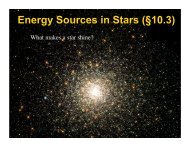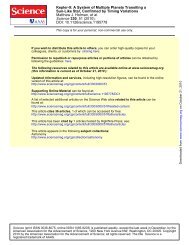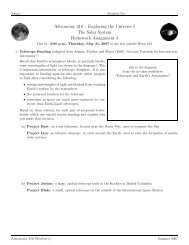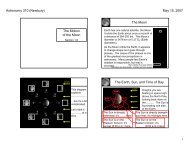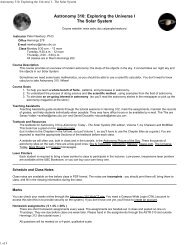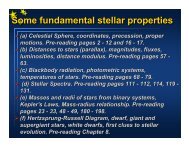Large Aperture Mirror Array (LAMA) - Astronomy and Astrophysics at ...
Large Aperture Mirror Array (LAMA) - Astronomy and Astrophysics at ...
Large Aperture Mirror Array (LAMA) - Astronomy and Astrophysics at ...
You also want an ePaper? Increase the reach of your titles
YUMPU automatically turns print PDFs into web optimized ePapers that Google loves.
<strong>Large</strong> <strong>Aperture</strong> <strong>Mirror</strong> <strong>Array</strong> (<strong>LAMA</strong>) – project overviewPaul Hickson 1a <strong>and</strong> Kenneth M. Lanzetta 2ba University of British Columbia; b Stony Brook UniversityABSTRACTThe <strong>Large</strong> <strong>Aperture</strong> <strong>Mirror</strong> <strong>Array</strong> (<strong>LAMA</strong>) is a novel concept for an extremely-large telescope. In the current design,light from 66 individual 6.15-meter telescopes would be coherently combined <strong>at</strong> a common focus. This would give thearray the light-g<strong>at</strong>hering power of a 50-meter telescope <strong>and</strong> the resolving power of a 70-meter telescope. The optics <strong>and</strong>beam combiner preserve the sine condition, providing interferometric imaging over an extended field of view. Theconcept is unique in th<strong>at</strong> pointing <strong>and</strong> tracking is accomplished entirely by secondary optical systems: the primarymirrors are fixed in both position <strong>and</strong> orient<strong>at</strong>ion. This allows rot<strong>at</strong>ing liquid-metal primary mirrors to be employed,substantially reducing the project cost. At a 30-degree l<strong>at</strong>itude, the tracking system provides access to approxim<strong>at</strong>ely2500 square degrees (6% of the sky) <strong>and</strong> allows individual fields to be observed for up to 35 min per night. Thetelescope would be initially equipped with a multi-b<strong>and</strong> optical/infrared imaging camera <strong>and</strong> a high-resolution opticalspectrograph.Keywords: telescopes, interferometers, adaptive optics, liquid mirrors1. INTRODUCTIONThe next gener<strong>at</strong>ion of ground-based optical telescopes will have apertures of 20 meters or more, <strong>and</strong> resolution <strong>at</strong> thediffraction limit. These telescopes will provide unprecedented scientific opportunities. Their development will providesignificant technical challenges. Historical scaling laws for costs of conventional telescopes predict th<strong>at</strong> the costs of suchfacilities will be truly monumental. These new telescopes will have to break the scaling laws by means of technologicalbreakthroughs <strong>and</strong> innov<strong>at</strong>ive design.The <strong>LAMA</strong> project offers the potential of providing the performance of a very large telescope <strong>at</strong> a cost th<strong>at</strong> is withinreach of a consortium of universities <strong>and</strong> research institutions. <strong>LAMA</strong> will achieve this cost saving in several ways. Thecost of conventional telescopes scales roughly as the 2.6 power of the diameter (i.e. roughly midway between the scalingof surface area <strong>and</strong> mass). Because <strong>LAMA</strong>’s aperture will be distributed over many individual telescopes, the cost isroughly proportional to the number of elements <strong>and</strong> therefore grows linearly with collecting area, or as the 2.0 power ofthe equivalent diameter. This corresponds to a cost savings of about a factor of four for the baseline <strong>LAMA</strong> design, ifthe conventional scaling laws remain valid for extremely-large telescopes. Also, the telescopes in an array are less tallthan a single large telescope would be, so the enclosure is less expensive. A major cost saving comes from the use ofrot<strong>at</strong>ing liquid-metal primary mirrors. These mirrors can provide a performance comparable to th<strong>at</strong> of conventional glassmirrors, <strong>at</strong> about 5% of the cost. Also, because the liquid primary mirrors do not tilt, the telescope structure can besimpler <strong>and</strong> much less massive.These savings in cost come <strong>at</strong> the expense of reduced capability. Specifically, <strong>LAMA</strong> will only observe near the zenith.The <strong>LAMA</strong> optical system allows the telescope to achieve diffraction-limited image quality up to a zenith angle of 4degrees, so it can observe only objects th<strong>at</strong> lie in an 8-degree wide strip of sky centered <strong>at</strong> declin<strong>at</strong>ion equal to theobserv<strong>at</strong>ory l<strong>at</strong>itude. At a l<strong>at</strong>itude of 30 degrees, this area contains approxim<strong>at</strong>ely 2500 square degrees – about 6% of thesky. The implic<strong>at</strong>ions of this have been considered in detail by the <strong>LAMA</strong> team, <strong>and</strong> we have concluded th<strong>at</strong> thisrestriction does not rule out many of the most interesting science programs th<strong>at</strong> we can foresee. Science programs for the1 hickson@physics.ubc.ca; phone 1 604 822 3853; fax 1 604 822 5324; http://www.astro.ubc.ca/people/hickson;University of British Columbia, Vancouver, BC V6T1Z1, Canada; 2 lanzetta@sbastr.ess.sunysb.edu; phone 1 631 6328222; fax 1 631 632 8176; Stony Brook University, Stony Brook, NY 11794, USA;
<strong>LAMA</strong> telescope, <strong>and</strong> tradeoffs associ<strong>at</strong>ed with the restricted pointing <strong>and</strong> tracking capability, are described in somedetail in a companion paper in these proceedings 1 .2. CONCEPTUAL DESIGNOur concept for the <strong>LAMA</strong> telescope is a set of individual telescopes arranged in a close-packed hexagonal array. Lightcollected by each telescope is collim<strong>at</strong>ed <strong>and</strong> relayed to a central room. Here the individual light beams are focused toform a common image by means of a Fizeau beam combiner. Each telescope would be provided with an adaptive opticssystem th<strong>at</strong> would remove phase distortion in the beam to the diffraction limit. Beams from the individual telescopeswould be combined either incoherently or coherently. In incoherent mode, the resulting image would have an angularresolution q ~ l/D corresponding to the diffraction limit of the individual telescopes (having aperture diameter D) butwith an image intensity corresponding to the light collecting area A of the entire array. Coherent beam recombin<strong>at</strong>ionwould provide angular resolution q ~ l/d corresponding to the diffraction limit of the array (having outside diameter d).This requires equaliz<strong>at</strong>ion of the optical p<strong>at</strong>h lengths for all beams <strong>and</strong> phase tracking systems to equalize the phases ofall beams to within a few hundredths of a radian.A unique fe<strong>at</strong>ure of the <strong>LAMA</strong> telescope is the use of low-cost liquid primary mirrors. The optical axis of a liquid mirrorcorresponds to the rot<strong>at</strong>ion axis, which must be vertical (with the possible exception of tilted viscous liquid mirrors 2 ).Therefore, the <strong>LAMA</strong> primary mirrors cannot be tilted. Pointing <strong>and</strong> tracking is accomplished by secondary opticalelements, which move to acquire <strong>and</strong> follow targeted fields, while <strong>at</strong> the same time correcting optical aberr<strong>at</strong>ions. Ourpreliminary tracking-optics design gives diffraction-limited performance for zenith angles up to 4 degrees. This allowsthe <strong>LAMA</strong> telescope to access approxim<strong>at</strong>ely 6% of the entire sky (~2400 square degrees), <strong>and</strong> track fields for up to 30min each night, if it is loc<strong>at</strong>ed <strong>at</strong> moder<strong>at</strong>e l<strong>at</strong>itude.In imaging mode, the <strong>LAMA</strong> telescope will observe fields surrounding stars, of approxim<strong>at</strong>ely 14 th magnitude, th<strong>at</strong> willserve as reference sources for the adaptive <strong>and</strong> phase tracking systems. There are several hundred thous<strong>and</strong> suitable starswithin the accessible area of sky.The <strong>LAMA</strong> telescope would also have the capability for high-resolution optical spectroscopy. This mode would be used,for example, to obtain spectra of the Lyman-a forest in high-redshift quasars, absorption spectra of the <strong>at</strong>mospheres ofplanets transiting in front of their host stars, etc. In this mode, light from individual telescopes would be transported byoptical fibers to a number of fixed echelle spectrographs. As the targets are rel<strong>at</strong>ively bright, <strong>and</strong> sp<strong>at</strong>ially-resolvedspectroscopy is not required, low-order adaptive correction (tip-tilt, focus) is all th<strong>at</strong> is required. This will beaccomplished by diverting a few percent of the light from the target star or quasar to the wavefront sensors of theindividual telescopes.3. ARRAY CONFIGURATIONThere are many possible configur<strong>at</strong>ions for the array th<strong>at</strong> meet the requirements of light collecting area <strong>and</strong> resolution.Obviously, one can have a small number of large apertures, or a large number of small apertures. For simplicity <strong>and</strong> toreduce costs, we require th<strong>at</strong> all individual telescopes in the array be identical as far as possible, <strong>and</strong> therefore have thesame aperture size. The resolution <strong>and</strong> sensitivity of a coherent array is a function of the array configur<strong>at</strong>ion (i.e.entrance pupil geometry).3.1. SensitivityFor a given total light collecting area, large separ<strong>at</strong>ions between apertures give higher resolution but lower sensitivity tofaint point sources (when fluctu<strong>at</strong>ions in the intensity of background or foreground light provide the dominant source ofnoise). As is well known, the point-spread function (PSF) of a coherent array consists of a central core surrounded byside-lobes or “s<strong>at</strong>ellite images”. To a good approxim<strong>at</strong>ion, the fraction of the total light th<strong>at</strong> falls in the central core isequal to the filling factor of the array (the r<strong>at</strong>io of light collecting area to the total geometrical area within a circular areabounding the array) 3 . However, as has been emphasized by Angel 4 , one should make use of not just the core but also thesidelobes. The most efficient way to do this is to weight each pixel in the image by the PSF. This technique (called
m<strong>at</strong>ched filtering or PSF fitting) produces the maximum signal-to-noise r<strong>at</strong>io for the detection <strong>and</strong> measurement of faintpoint sources against a uniform noise background. In this case, the sensitivity of the telescope (defined here as thereciprocal of the time required to reach a given signal to noise r<strong>at</strong>io) is proportional to the integral of the square of thePSF,S ~ A I 2 (x, y)dxdyÚwhere A is the total light-collecting area <strong>and</strong>, I (x, y) is the PSF, normalized so th<strong>at</strong> I (0,0) = 1. By Parseval’s theorem,this equ<strong>at</strong>ion may be written in terms of the modul<strong>at</strong>ion transfer function (MTF) t (u,u) , which is proportional to the†Fourier transform of the PSF,††S ~ A -1Ú t (u,u) 2 dudu .†From Fourier optics theory, the MTF is the autocorrel<strong>at</strong>ion of the pupil function P(u,u), which takes the value 1 insidethe aperture of any telescope in the array <strong>and</strong> 0 elsewhere. Therefore the sensitivity is proportional to the integral of thesquare of the autocorrel<strong>at</strong>ion of the array†pupil function. For a circular aperture of diameter D, the MTF is a circularlysymmetriccone-shaped function, having a height of (pD /4) 2 <strong>and</strong> a base diameter of 2D . The integral of the square of†this function is therefore proportional to D 6 . For an array of such apertures, the MTF is the sum of many such cones –one of unit amplitude loc<strong>at</strong>ed <strong>at</strong> the tip of each baseline vector in the u-u plane, <strong>and</strong> one of amplitude N <strong>at</strong> the origin.††If the array is sparse (widely separ<strong>at</strong>ed apertures) <strong>and</strong> non-redundant (all baselines differ by more than 2D) then there is†no overlap of these cones. As there are N(N-1) baselines in an N-element array, the r<strong>at</strong>io of sensitivity of such an array,compared to a single equivalent-area aperture of diameter N 1/ 2 D will beQ = N 2 + N (N -1)=† N 32N -1N 2 .This shows th<strong>at</strong> sparse, non-redundant imaging arrays have a sensitivity loss, of order N -1 when N is large, compared toan equivalent-area filled aperture telescope. Note th<strong>at</strong>, for a sparse array, when the entire PSF is used instead of just the†core, the sensitivity depends only on the number of elements <strong>and</strong> not on the filling factor.The situ<strong>at</strong>ion is improved if the baselines have a high degree ofredundancy or if the separ<strong>at</strong>ions between apertures is made less than2D. This causes the cones to overlap <strong>and</strong>, by virtue of the square in theintegr<strong>and</strong>, results in a boost in sensitivity. For dense highly-redundantarrays, the sensitivity approaches th<strong>at</strong> of a filled-aperture telescope.(These results, obtained by analysis in the Fourier domain, agree withthose of Angel 4 whose analysis was done in real image space.)For this reason, we have chosen to place the individual telescopes ofthe <strong>LAMA</strong> array as close together as is practical. A hexagonalgeometry is adopted, in order to maximize redundancy <strong>and</strong> minimizesepar<strong>at</strong>ions. The final choice of aperture size vs. number of elementshas not yet been made. It will be driven in part by practicalconsider<strong>at</strong>ions such as costs <strong>and</strong> available sizes of air bearings,adaptive mirrors, aspheric optics, etc.†For the baseline <strong>LAMA</strong> design, we have selected a configur<strong>at</strong>ion th<strong>at</strong>employs 66 apertures, each having a clear diameter of 6.15 m. Thearray geometry is illustr<strong>at</strong>ed in Figure 1. The elements are placed on ahexagonal l<strong>at</strong>tice, filling an annular region with outer diameter of 100m <strong>and</strong> inner diameter of 20 m. The center-to-center separ<strong>at</strong>ion of arrayelements is 7.5 m. The sensitivity of this configur<strong>at</strong>ion, compared to aFigure 1. <strong>Array</strong> geometry for the baseline<strong>LAMA</strong> design. 66 apertures, of diameter6.15 m, are deployed in an annular regionof outer diameter 70 m <strong>and</strong> inner diameter20 m.
single-aperture 50-meter telescope is 0.512, which makes <strong>LAMA</strong> equal in sensitivity to a filled-aperture telescope ofdiameter 35.8 m.†An advantage of the 6.15 m aperture size is th<strong>at</strong> it is well-m<strong>at</strong>ched to dynamic range <strong>and</strong> actu<strong>at</strong>or density of availablepiezoelectric deformable mirrors. In a simple adaptive optics system, the deformable mirror must remove <strong>at</strong>mosphericphase errors of higher order than wavefront tilt (which is removed by a separ<strong>at</strong>e tip-tilt mirror). For a Kolmogorovturbulence spectrum, the residual RMS <strong>at</strong>mospheric phase error over a diameter D, after removal of tip-tilt, iss j = 0.94 ( D /r 0 ) 5 / 6 . The actu<strong>at</strong>or stroke needed to correct this (<strong>at</strong> the 5s level) is approxim<strong>at</strong>ely Dz = 0.37l ( D /r 0 ) 5 / 6 ,which is independent of wavelength since r 0 µ l 6 / 5 . If the required phase correction exceeds the stroke of the actu<strong>at</strong>or,phase coherence across the pupil will be momentarily lost. In normal AO imaging this means th<strong>at</strong> image quality ismomentarily lost, then restored after the <strong>at</strong>mospheric excursion. † For interferometry, the situ<strong>at</strong>ion†is more critical. Loss ofphase coherence can lead to loss fringes in the phase tracking system, resulting in loss of coherence in the entire array.Phase tracking can only be re-established † by scanning the piston mirrors until the fringes are found, a process th<strong>at</strong> couldrequire some time. Therefore it is important th<strong>at</strong> the deformable mirrors have sufficient dynamical range. The maximumstroke th<strong>at</strong> can be obtained with commercially-available piezoelectric deformable mirrors, of which we are aware, is 8um. If we adopt a value of r 0 ª 0.1 m <strong>at</strong> l = 0.5 um (the 90-percentile value recorded <strong>at</strong> the WHT site <strong>at</strong> La Palma 5 ), wefind th<strong>at</strong> D < 9.2 m.( ) 2 . At present, deformableThe number of actu<strong>at</strong>ors†required for high-Strehl AO correction is of order N A = D /r 0† mirrors have been made with ~ 10 3 actu<strong>at</strong>ors. This limits the telescope diameter to D ~ 30r 0 if full AO performance is tobe achieved. The 6.15 m diameter allows high-Strehl AO performance to be achieved for r 0 as small as 0.20 m, which isfound 90% of the time <strong>at</strong> a wavelength of 0.9 um <strong>at</strong> La Palma.††.4. OPTICS†The optical design is perhaps the most challenging aspect of the <strong>LAMA</strong> telescope. Not only do the individual elementshave to point <strong>and</strong> track, without moving their primary mirrors, but also, the beams from all telescopes need to be broughtto a single common focus. In coherent mode, the optical p<strong>at</strong>hlengths must be equalized <strong>and</strong> the beams must all be cophased.At the same time, we aim to do all this over an extended field of view. A complete <strong>and</strong> final optical design hasnot yet been achieved. R<strong>at</strong>her, progress has been made in all areas resulting in <strong>at</strong> least a conceptual design for all aspectsof the system. Here we provide only an example of an optical system th<strong>at</strong> can, <strong>at</strong> least in principle, achieve ourrequirements.4.1. RequirementsThe optical design is driven by two unique fe<strong>at</strong>ures of the <strong>LAMA</strong> concept – the need to point <strong>and</strong> track, without movingthe primary mirrors, <strong>and</strong> the need to combine the light from many telescopes to provide coherent imaging over anextended field of view. The optical system is divided into two main subsystems th<strong>at</strong> address these needs. The trackingsystem consists of the primary mirror <strong>and</strong> a set of “secondary” mirrors th<strong>at</strong> move to acquire <strong>and</strong> follow the field, <strong>and</strong>which must correct all aberr<strong>at</strong>ions, to the diffraction limit. The p<strong>at</strong>hlength-compens<strong>at</strong>ion <strong>and</strong> pupil-relay system receiveslight from the tracking system <strong>and</strong> relays it to the final combined focus. This system includes mirrors th<strong>at</strong> move in orderto equalize the optical p<strong>at</strong>h lengths, <strong>and</strong> mirrors th<strong>at</strong> re-image the telescope entrance pupil, producing an exit pupilhaving the required characteristics.In order for an interferometer to produce extended coherent images, it is necessary th<strong>at</strong> differences in optical p<strong>at</strong>h lengthsfor points in the image plane th<strong>at</strong> are not on the optical axis exactly compens<strong>at</strong>e for differences produced by the slope ofthe incident wavefront coming from the corresponding field angles. A necessary <strong>and</strong> sufficient condition for this is th<strong>at</strong>the array s<strong>at</strong>isfy the Abbé sine condition: the sin of the angle of incidence of every ray reaching the axial focal pointmust be strictly proportional to the (projected) distance from the axis of the corresponding ray in the entrance pupil.This condition can be achieved, for example, by arranging the exit pupils of the individual telescopes on a spherecentered on the axial focal point <strong>and</strong> requiring th<strong>at</strong> 1) the angle between the axis <strong>and</strong> the center of each exit pupil,
measured <strong>at</strong> the focal point, is proportional to the radial distance of the center of the entrance pupil from the axis,projected on a plane perpendicular to the line of sight to an object <strong>at</strong> the center of the field of view, 2) The angularposition, seen from the focal point, of any point in the exit pupil of any telescope be proportional to the radial position ofthe corresponding point in the telescope entrance pupil, with the same proportionality factor as above, 3) The azimuthangles of corresponding points in the entrance <strong>and</strong> exit pupils be identical. Effectively this means th<strong>at</strong> the entrance pupilof the array must map homogeneously onto the exit pupil with constant magnific<strong>at</strong>ion. There can be no significantdistortion of the pupils, no pupil rot<strong>at</strong>ion, <strong>and</strong> the parity of the exit pupil must m<strong>at</strong>ch th<strong>at</strong> of the entrance pupil. Imaginginterferometer th<strong>at</strong> s<strong>at</strong>isfy these requirements are said to be Fizeau.The accuracy with which the Fizeau requirements are s<strong>at</strong>isfied determines the field of view of the interferometer. Forexample, a radial distortion Dr /r in the entrance pupil, will result in a phase error of one radian for marginal rays <strong>at</strong> afield angle q ª rDq /pDr , where Dq ª l /d is the angular resolution of the coherent array. Therefore, in order to obtainan image having, say, 10 6 resolution elements, the pupil distortion must be less than ~ 0.06%.The complexity of†the optical design problem can be illustr<strong>at</strong>ed by itemizing the requirements of the system. It must††• Deliver light to fixed common focus with no focal plane curv<strong>at</strong>ure or tilt• Point <strong>and</strong> track within 4º of the zenith (without moving the primary mirrors)• Have no field distortion, or vari<strong>at</strong>ion in image scale, during tracking• Image the pupil with negligible distortion <strong>and</strong> correct orient<strong>at</strong>ion <strong>and</strong> parity• Provide optical p<strong>at</strong>h length vari<strong>at</strong>ion <strong>and</strong> control over ~ 5 m during tracking• Provide longitudinal <strong>and</strong> l<strong>at</strong>eral control of the pupil position during tracking• Allow no rot<strong>at</strong>ion, or change in magnific<strong>at</strong>ion, of the pupil image during tracking• Provide a deformable mirror <strong>at</strong> a pupil <strong>and</strong> fast tip-tilt <strong>and</strong> piston mirrors• Employ reflecting optics only (except windows, filters)• Minimize the number of reflections, obscur<strong>at</strong>ion <strong>and</strong> vignetting• Provide diffraction-limited image quality in all configur<strong>at</strong>ionsTo achieve these goals, we divide the optical system into several functional groups – the tracking system, the p<strong>at</strong>hlengthcontrol system, <strong>and</strong> the pupil relay system. These are now discussed in turn.4.2. Tracking systemThe telescopes must point <strong>and</strong> track without moving the primary mirrors. This can in principle be achieved, in eachtelescope, by moving an optical relay system th<strong>at</strong> traverses the focal surface of the primary mirror, much like theimaging system of the Arecibo radio telescope. A critical requirement is th<strong>at</strong> the optical system not only remove the offaxisaberr<strong>at</strong>ions of the primary mirror, but th<strong>at</strong> it also be free from distortion <strong>and</strong> focal-plane tilt. Because <strong>LAMA</strong> willtake extended exposures, up to ~ 30 min, no differential image motion can be toler<strong>at</strong>ed.These requirements can be met providing th<strong>at</strong> the axis of optical system passes through the center of curv<strong>at</strong>ure of theprimary mirror <strong>at</strong> all times during the tracking 6 . If the primary mirrors were spherical, such a system would n<strong>at</strong>urallyhave no zenith-angle-dependent distortion, <strong>and</strong> need correct only spherical aberr<strong>at</strong>ion. For parabolic primary mirrors (asis the case with rot<strong>at</strong>ing liquid mirrors), the situ<strong>at</strong>ion is more complex but can be solved by providing a “paraboliccompens<strong>at</strong>or” optically conjug<strong>at</strong>e to the primary mirror, which has the effect of converting the parabolic form back into asphere. This mirror must move l<strong>at</strong>erally during tracking, in order to remain conjug<strong>at</strong>e to the primary mirror.One possible configur<strong>at</strong>ion for this system is shown in Figure 2. A small Schmidt telescope forms a high-qualitydistortion-free image of the primary mirror. This image is loc<strong>at</strong>ed <strong>at</strong> the position of parabolic compens<strong>at</strong>or mirror <strong>and</strong> thecurv<strong>at</strong>ure of this image is m<strong>at</strong>ched to the curv<strong>at</strong>ure of the parabolic compens<strong>at</strong>or. This mirror has a large asphericdeparture, equal <strong>and</strong> opposite to th<strong>at</strong> of the primary mirror.
Upon reflection from the parabolic compens<strong>at</strong>or, thebeam contains a considerable amount of sphericalaberr<strong>at</strong>ion, equal to th<strong>at</strong> of a spherical primary mirror.The spherical aberr<strong>at</strong>ion is removed by a two-mirrorcorrector. The beam exiting this corrector is directed tothe central beam combining room by means of a fl<strong>at</strong>“tertiary” mirror loc<strong>at</strong>ed a short distance above theprimary mirror. In addition to these elements, two fl<strong>at</strong>mirrors are used to fold the beam before it enters theSchmidt telescope. These allow us to direct the axis ofthe tracking system, <strong>and</strong> therefore the output beam, to thetertiary mirror.As the telescope points <strong>and</strong> tracks, this system moveshorizontally, <strong>and</strong> vertically to a lesser extent, in order tofollow the image produced by the primary mirror. Asrequired to elimin<strong>at</strong>e focal plane tilt <strong>and</strong> distortion, theoptical axis of this system is constrained to pass throughthe image of the center of curv<strong>at</strong>ure formed by the largefl<strong>at</strong> mirror <strong>at</strong> the top of the picture.This system can provide diffraction-limited images over a30 arcsec field of view up to 4° from the zenith. The maindisadvantage of this configur<strong>at</strong>ion is the obscur<strong>at</strong>ionproduced by the parabolic compens<strong>at</strong>or. Atapproxim<strong>at</strong>ely 16%, this is not insignificant. We arecurrently investig<strong>at</strong>ing altern<strong>at</strong>ive designs with the aim ofreducing the obscur<strong>at</strong>ion <strong>and</strong> extending the instantaneousfield of view to <strong>at</strong> least one arcmin.Figure 2. Optical configur<strong>at</strong>ion of the tracking system.During tracking, the system moves l<strong>at</strong>erally, traversingthe focal surface of the primary mirror. At the sametime, the parabolic compens<strong>at</strong>or pivots about its centerof curv<strong>at</strong>ure in order to maintain alignment with theimage of the primary mirror. The fl<strong>at</strong> mirror <strong>at</strong> the topof the figure tilts slightly to ensure th<strong>at</strong> the (reflected)axis of the tracking system passes through the center ofcurv<strong>at</strong>ure of the primary mirror.4.3. P<strong>at</strong>hlength compens<strong>at</strong>ion <strong>and</strong> pupil relay system†The <strong>Large</strong>-<strong>Aperture</strong> <strong>Mirror</strong> <strong>Array</strong> will achieve high angular resolution by coherently combining light from manyindividual telescopes. As with any interferometer, the total optical p<strong>at</strong>h length, measured from an incident wavefront tothe final focus, must be the same for all rays, to within a fraction of the coherence length Rl , where R = l /Dl is thespectral resolving power. For broad-b<strong>and</strong> imaging, R ~ 5 so the required p<strong>at</strong>h-length tolerances are of the same order asthe wavelength. The optics must therefore provide a means for controlling the optical p<strong>at</strong>h length, <strong>and</strong> varying itsmoothly as the telescope tracks. This problem has been solved by other interferometers, which employ a combin<strong>at</strong>ion ofslow-moving long-travel <strong>and</strong> short-throw high b<strong>and</strong>width mirrors. For <strong>LAMA</strong>,†the problem†is simplified somewh<strong>at</strong>because the telescope never points far from†the zenith. The varying component of optical p<strong>at</strong>h length is r sinz where r isthe horizontal distance of the telescope from the center of the array <strong>and</strong> z is the zenith angle. This term takes values upto ±2.23 m for the baseline design, which is much less than th<strong>at</strong> required by other interferometers such as VLTI. Theoptics for each telescope must therefore provide a variable p<strong>at</strong>h length, between the entrance <strong>and</strong> exit pupil, of about 5m.††A complic<strong>at</strong>ion results from the need to provide coherent imaging over an extended field of view. As described above,this requires th<strong>at</strong> the exit pupil of the array be a demagnified copy of the entrance pupil. The <strong>LAMA</strong> optics musttherefore control the longitudinal position of the exit pupil, while the optical p<strong>at</strong>hlength changes, in order to keep it <strong>at</strong> theappropri<strong>at</strong>e position on the beam combiner mirror. During this motion, there must be no change in the exit pupildiameter. Also, the exit pupil must move l<strong>at</strong>erally a few mm in order to compens<strong>at</strong>e for the cosz compression of the†
projected (perpendicular to the line of sight) distance of the individual telescope entrance pupil from the geometricalcenter of the array.An optical configur<strong>at</strong>ion th<strong>at</strong> can perform all of these functions is illustr<strong>at</strong>ed in Figure 3. L<strong>at</strong>eral motion of the concave“p<strong>at</strong>hlength control” mirror changes the optical p<strong>at</strong>h length of the system. At the same time, the fl<strong>at</strong> “focus” mirrormoves to ensure th<strong>at</strong> the focal point of the p<strong>at</strong>hlength control mirror remains coincident with the intermedi<strong>at</strong>e imageproduced by the tracking system. Thus, while the optical p<strong>at</strong>h length from this image to the p<strong>at</strong>hlength control mirrordoes not change, the distance from the p<strong>at</strong>hlength control mirror to the final focus does change, as required.The pupil positioning system is a pair of mirrors th<strong>at</strong> form an afocal beam compressor. Longitudinal transl<strong>at</strong>ion of thispair of mirrors has no effect on the magnific<strong>at</strong>ion or position of the final image because both the input <strong>and</strong> output beamsremain afocal. It also has no effect on the optical p<strong>at</strong>h length. However, transl<strong>at</strong>ion of this system does change theposition of the pupil image. A small range of travel (less than a meter) is sufficient to keep the pupil image <strong>at</strong> the desiredexit pupil loc<strong>at</strong>ion on the beam combiner “deformable mirror”. A small l<strong>at</strong>eral transl<strong>at</strong>ion of the diagonal fl<strong>at</strong> mirror (lessthan 2 mm) suffices to compens<strong>at</strong>e for the cosz compression of the corresponding entrance pupil position.Co-planarity of the images from all systems is ensured by requiring th<strong>at</strong> the concave beam-combiner mirrors for alltelescopes lie on a parent sphere whose focus coincides with the final combined image.†Figure 3. Optical configur<strong>at</strong>ion of the p<strong>at</strong>hlength compens<strong>at</strong>ion <strong>and</strong> pupil relay system. As described in the text, thissystem is capable, in principle, of s<strong>at</strong>isfying the optical p<strong>at</strong>h length, exit pupil loc<strong>at</strong>ion <strong>and</strong> beam recombin<strong>at</strong>ionrequirements for coherent imaging over an extended field of view.4.4. Adaptive <strong>and</strong> phase tracking systemsEach telescope in the <strong>LAMA</strong> array will be equipped with an adaptive-optics (AO) system capable of near-diffractionlimitedperformance <strong>at</strong> least for near-infrared wavelengths. The current baseline design requires only conventional AOemploying a single wavefront sensor <strong>and</strong> deformable mirror for each telescope. However, we are considering thepotential use of multi-conjug<strong>at</strong>e adaptive optics (MCAO), <strong>at</strong> least for some fields. <strong>LAMA</strong> would not require laser guide
stars. Instead, one would target fields th<strong>at</strong> contain one or more n<strong>at</strong>ural stars suitable for AO reference. There are manysuitable fields available within the area of sky accessible to the telescope 1 .The adaptive system for each telescope will include a deformable mirror loc<strong>at</strong>ed <strong>at</strong> a pupil th<strong>at</strong> provides ground-layerturbulence compens<strong>at</strong>ion in addition to removing small residual optical aberr<strong>at</strong>ions of the tracking system. A seconddeformable mirror could also be included, loc<strong>at</strong>ed conjug<strong>at</strong>e to high-altitude turbulence, for MCAO. A fast tip-tilt mirror<strong>and</strong> focus mirror would be used to lower the dynamic range <strong>and</strong> stroke required of the deformable mirrors. A dichroicbeam splitter, loc<strong>at</strong>ed in the beam converging to the final focus would feed conventional wave-front sensors. A controlsystem would be provided for each telescope. These systems would act independently in removing phase errors for eachtelescope.P<strong>at</strong>hlength <strong>and</strong> phase control would be accomplished by slow-moving the p<strong>at</strong>hlength control mirrors <strong>and</strong> fast-movingpiezoelectric piston mirrors. This system would be controlled by a closed-loop control system employing opticalmetrology for mirror position inform<strong>at</strong>ion, <strong>and</strong> a high-speed phase tracking system. The phase tracking system wouldemploy high-sensitivity solid Michelson interferometers (Figures 4 <strong>and</strong> 5) to detect <strong>and</strong> track interference fringesbetween pairs of telescopes. These interferometers would be loc<strong>at</strong>ed in parallel light beams reflected from a parabolicwindow loc<strong>at</strong>ed in front of the combined focus. The interferometer units would straddle adjacent beams, with each beamfeeding up to three interferometers. In this way, phase coherence can be achieved for the entire array by combining pairwisephase measurements. Redundancy would be provided to control propag<strong>at</strong>ion errors in this scheme.Figure 4. Loc<strong>at</strong>ion of phase sensors used forinterferometric imaging. A parabolic window placedbefore the focus reflects a few percent of the lightdownward in parallel beams having the same geometryas the exit pupil. Phase sensors, shown in Figure 5,intercept a portion of light from adjacent beams,thereby measuring the pairwise phase differences.Figure 5. Solid Michelson interferometer phase sensor.Two prisms employ total internal reflection to directincoming light to a partially aluminized interface. Theintensities of the exiting beams are measured byavalanche photodiode detectors
5. TELESCOPE STRUCTUREAs illustr<strong>at</strong>ed in Figure 6, the major components of each individual <strong>LAMA</strong>telescope will be the primary mirror system, a tracking optical system loc<strong>at</strong>ednear the prime focus, a fl<strong>at</strong> “tertiary” mirror loc<strong>at</strong>ed a short distance abovethe primary mirror vertex, <strong>and</strong> a hexapod structure th<strong>at</strong> supports the trackingsystem <strong>and</strong> provides the motion needed for pointing <strong>and</strong> tracking. Theprincipal mechanical components of the telescope structure are the hexapod,<strong>and</strong> a spider th<strong>at</strong> supports the tertiary mirror. The <strong>LAMA</strong> telescopes wouldtherefore resemble the <strong>Large</strong> Zenith Telescope (LZT), which has both ahexapod <strong>and</strong> a spider (see Figure 6 of the next section). However, the <strong>LAMA</strong>hexapod must be capable of gre<strong>at</strong>er displacement, as the top end needs tomove approxim<strong>at</strong>ely 2.5 m horizontally <strong>and</strong> a few cm vertically duringtracking. As the hexapod partly obscures the primary mirror, its crosssectionalarea will be made as small as is feasible. At the same time, it mustbe sufficiently stiff to resist excit<strong>at</strong>ion of its lowest frequency eigenmodes bywind within the enclosure. The LZT hexapod obscures 6% of the incidentlight; experience indic<strong>at</strong>es th<strong>at</strong> this can be reduced for the <strong>LAMA</strong> design.The spider provides bracing, bearing l<strong>at</strong>eral loads produced by the weight ofthe hexapod <strong>and</strong> tracking system. It supports the tertiary mirror <strong>and</strong> its baffle.The tertiary mirror, <strong>and</strong> its baffle, must articul<strong>at</strong>e to follow the motion of thetracking system, delivering light to a fixed loc<strong>at</strong>ion in the central beamcombinerroom.Figure 6. Schem<strong>at</strong>ic model of an individual telescopes in the <strong>LAMA</strong> array. Shown are the rot<strong>at</strong>ing liquid primary mirror,a hexapod supporting the optical tracking system, <strong>and</strong> a spider supporting the tertiary mirror <strong>and</strong> baffle system.6. PRIMARY MIRRORSTo reduce cost, <strong>LAMA</strong> will employ rot<strong>at</strong>ing liquid-metal primary mirrors. Liquid mirror telescopes, employing a film ofmercury as the reflecting surface, have been in oper<strong>at</strong>ion now for more than a decade. One of these, the 3-meter NASAOrbital Debris Observ<strong>at</strong>ory (NODO), has been used both for the detection <strong>and</strong> characteriz<strong>at</strong>ion of space debris, <strong>and</strong> forastronomical observ<strong>at</strong>ions 7 . Details of its oper<strong>at</strong>ion <strong>and</strong> performance have been documented by Mulrooney 8 . A recentanalysis 9 of its image quality indic<strong>at</strong>es th<strong>at</strong> the surface accuracy of its liquid mirror is approxim<strong>at</strong>ely 80 nm RMS.The most recent, <strong>and</strong> largest, liquid-mirror telescope is the 6-meter <strong>Large</strong> Zenith Telescope 10 (Figure 7) which hasrecently seen first light (Figure 8). The LZT employs two new fe<strong>at</strong>ures th<strong>at</strong> are expected to result in a mirror surfaceaccuracy th<strong>at</strong> is substantially better than th<strong>at</strong> of previous liquid-mirror telescopes. The first of these is improvedrot<strong>at</strong>ional speed stability. Previous liquid-mirror telescopes such as NODO employ open-loop speed control, in which therot<strong>at</strong>ion frequency of the magnetic field gener<strong>at</strong>ed by the motor windings is precisely controlled As this system has nofeedback, the instantaneous speed of the mirror is subject to fluctu<strong>at</strong>ions, of as much as 100 ppm, caused by wind <strong>and</strong>other disturbances. Such fluctu<strong>at</strong>ions result in flow of mercury on the surface, degrading image quality. The LZT, whichemploys closed-loop servo control of the primary mirror rot<strong>at</strong>ion, achieves a constant mirror rot<strong>at</strong>ion speed to within 1ppm under all environmental conditions.
The second fe<strong>at</strong>ure of the LZT is the thinness of the mercury layer. Labor<strong>at</strong>ory tests of liquid-mirrors 11 indic<strong>at</strong>e th<strong>at</strong>surface waves, induced by vibr<strong>at</strong>ions <strong>and</strong> air turbulence, essentially disappear when the thickness of the mercury film isreduced to 1 mm or less. Because a film several mm thick is required to overcome surface tension whcn starting themirror, the LZT is equipped with a pumping system capable of removing mercury from the rot<strong>at</strong>ing mirror after themercury film has stabilized <strong>and</strong> oxidized.Figure 6. The 6-m liquid mirror of the <strong>Large</strong> Zenith Telescope.Figure 7. A “first-light” image obtained with<strong>Large</strong> Zenith Telescope.Fabric<strong>at</strong>ion possibilities for the <strong>LAMA</strong> primary mirrors are presently being investig<strong>at</strong>ed. It appears likely th<strong>at</strong> these canbe most conveniently made by machining aluminum sectors. These sectors could be readily transported <strong>and</strong> assembledon site to make complete mirrors. Further details are given in an accompanying paper, in these proceedings, th<strong>at</strong>describes the <strong>LAMA</strong> Prototype Telescope 12 .7. INSTRUMENTATIONThe initial complement of instruments for <strong>LAMA</strong> would include an optical/infrared imaging camera <strong>and</strong> a highresolutionspectrograph. These would be the primary dark-time <strong>and</strong> bright-time instruments, respectively. The imagingcamera would be loc<strong>at</strong>ed <strong>at</strong> the combined focus of the array where it would be used in both incoherent <strong>and</strong> coherentimaging mode. Different images scales would be provided for these two modes in order to properly sample therespective PSFs. This camera would employ dichroic beam splitters in order to provide simultaneous broad-b<strong>and</strong>imaging, with spectral resolving power R ~ 5 over the 0.3-2.5 um wavelength range. As currently foreseen, this camerawould employ 4k x 4k CCDs for the optical channels <strong>and</strong> 2k x 2k HgCdTe arrays for the infrared channels.The high-resolution spectrograph would be designed for R ~ 300,000 spectroscopy of individual objects, such as highredshiftquasars, host stars of transiting planets, etc. It would consist of a bank of approxim<strong>at</strong>ely 10 cross-dispersed†echelle spectrographs. Each spectrograph would receive light from several individual telescopes via optical fibers. Eachfiber would sample the intermedi<strong>at</strong>e image produced by the tracking system. These images are loc<strong>at</strong>ed inside the beamcombiner room, <strong>at</strong> the entrance to the p<strong>at</strong>hlength † compens<strong>at</strong>ion systems (see Figure 3). By dividing the light between anumber of individual spectrographs, each sized for the individual <strong>LAMA</strong> telescopes, one avoids the considerabledifficulty of designing <strong>and</strong> building a high-resolution spectrograph for a 50-m telescope.
8. SUMMARYThis paper has outlined current ideas for the <strong>LAMA</strong> telescope array. The central aim of this project is to achieve thelight-g<strong>at</strong>hering power <strong>and</strong> resolution of a 50-metre telescope by combining the light from a large number of individualliquid-mirror telescopes. We have shown how these telescope can be made to point <strong>and</strong> track, near the zenith, providingaccess to 6% of the sky <strong>and</strong> exposure times of up to 30 min. Adaptive optics systems yield the diffraction limit of theindividual telescope apertures. Coherent Fizeau beam combin<strong>at</strong>ion can, <strong>at</strong> least in principle, yield the diffraction limit ofthe 70-meter array configur<strong>at</strong>ion. The low cost of liquid mirrors makes <strong>LAMA</strong> <strong>at</strong>tractive for the many scientificprograms th<strong>at</strong> can be accomplished within the constraints imposed by its design.ACKNOWLEDGEMENTSThe <strong>LAMA</strong> conceptual design phase <strong>and</strong> development work is made possible by grants from Stony Brook <strong>and</strong> ColumbiaUniversities <strong>and</strong> from the N<strong>at</strong>ural Sciences <strong>and</strong> Engineering Research Council of Canada.REFERENCES1. K. M. Lanzetta <strong>and</strong> P. Hickson, “Science case for the <strong>LAMA</strong> telescope,” 2nd Bäckaskog Workshop on Extremely<strong>Large</strong> Telescopes, September 9-11, 20032. E. F. Borra <strong>and</strong> A-M. R. Ritcey, “Tiltable liquid-mirror telescopes,” Proc. SPIE., 4003, 331, 2000.3. F. Roddier <strong>and</strong> S. T. Ridgway, “Filling factor <strong>and</strong> signal-to-noise r<strong>at</strong>ios in optical interferometric arrays”, Pub.Astron. Soc. Pacific. 762, 990-996, 1999.4. J. R. P. Angel, “Sensitivity of optical interferometers with coherent image combin<strong>at</strong>ion,” Proc. SPIE., 4838, 126,2003.5. http://www.ing.iac.es/<strong>Astronomy</strong>/development/hap/dimm.html6. P. Hickson, “Wide-field tracking with zenith-pointing telescopes,” Mon..Not. Roy. Astron. Soc. 330, 540-546, 2002.7. A. Potter <strong>and</strong> M. K. Mulrooney,8. M. K. Mulrooney, “A 3.0 meter liquid-mirror telescope,” Ph.D. thesis, Rice University, 2000.9. P. Hickson <strong>and</strong> M. K. Mulrooney, “Image quality of liquid-mirror telescopes”, submitted to Pub. Astron. Soc.Pacific.10. P. Hickson, E. F. Borra, R. Cabanac, S. C. Chapman, V. de Lapparent, M. K. Mulrooney <strong>and</strong> G. A. H Walker,“<strong>Large</strong> Zenith Telescope project: a 6-m mercury-mirror telescope,” Proc. SPIE. . 3352, 226-232, 1998.11. L. Girard <strong>and</strong> E. F. Borra, “Optical tests of a 2.5-m-diameter liquid mirror: behavior under external perturb<strong>at</strong>ions<strong>and</strong> sc<strong>at</strong>tered-light measurements”, Appl. Optics, 36, 6278, 1997.12. B. E. Truax, K. M. Lanzetta <strong>and</strong> P. Hickson, “The <strong>LAMA</strong> Prototype Telescope,” 2nd Bäckaskog Workshop onExtremely <strong>Large</strong> Telescopes, September 9-11, 2003




